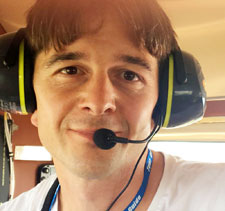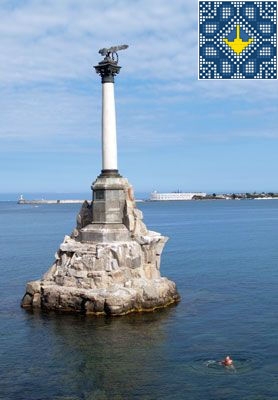|
Sevastopol Sights | Monument to the Scuttled Ships Individual and group tours to Sevastopol |
The monument was built in 1905 for the 50th anniversary of the First Defense of Sevastopol (1854-1855) during which were flooded Russian sailing ships and blocked up the entrance to Sebastopol Bay. In June-July 1854 the superior forces of the Allied navy (Britain, France, Turkey and Sardinia) - 34 battleships and 55 frigates (most of them were steam ships) blockaded the Russian fleet (14 sailing ships, six frigates and six steam-frigate) in Sevastopol Bay. On 9th of September vice-admiral Vladimir Kornilov assembled the military council. At the council he proposed to immediately attack the enemy's fleet which stood at the Cape Lucullus. According to him if successful could destroy the enemy ships and in case of failure - to blow up themselves and part of the Allied navy. But most of captains offered another plan. Block the path of the enemy and save the city can be scuttling the ships across the bay. Admiral Alexander Menshikov considered both points of view and agreed with military council. Vice-Admiral Vladimir Kornilov who was strongly against such a sacrifice had to obey the orders of Chief of the Army. The ships sunk during the night by shooting at them from guns. The sailors wept as they watched they disappear under water. On 11th of September 1854 plunged into the water seven vessels - five battleships and two frigates (battleships "Silistra", "Uriel", "Selafail", "Three Saints" and "Varna", frigates "Sizopol" and "Flora"). Between Konstantinov and Alexander batteries were just the tops of the masts over the sea surface. But soon the autumn storms began to destroy barrier of sunken ships. Therefore on 5th of November flooded 84-gun "Gabriel", on 14th of December - Corvette "Pylades," and on the night on 13th of February 1855 there was a second line between Michael and Nikolaev batteries. Then went to the bottom of sea the battleships "Twelve Apostles", "Svyatoslav", "Rostislav" and frigates "Cahul" and "Messembria". Three days later - the frigate "Mussel". 200-pood guns from sailing ships were transfered to the batteries. It is because of heavy naval guns transfered from sunken ships Sevastopol successfully repelled the enemy assaults and bombings. From the disbanded crews of sailing ships the garrison get more than 10 000 warriors who played a huge role in the defense of the city. On the night of 27-28 of August 1855 during the transition to the North side of Sevastopol were flooded remains of the Black Sea Fleet: 7 battleships, frigate, corvette and 5 brigs. Thus except the frigate "Berezan" and several smaller vessels that were destroyed by fire of enemy artillery during the siege - the rest of Black Sea Fleet - totally 91 ships were flooded by Black Sea sailors. The news of the sunken ships across the raid of Sevastopol Bay was unexpected for the Allies. English Admiral tore his hair of anger and the commander of the French fleet later wrote that if the Russian is not blocked the entrance to the bay the Allies fleet after the first battle entered there. At the end of October 1854 on the ship "Prince" of England came to Balaklava secret equipment for explode of underwater part of the "sunken ships wall". However mines and diving equipment were lost along with the ship during the storm on 14th of November 1854. In the November storm in the Crimean coast were destroyed more than 30 ships, 40 were seriously damaged. As acknowledged by many modern researchers of maritime disasters in history there are few examples of the simultaneous loss of so many first-class ships. Losses totaled more than 2 million pounds, the morale of the army besieging Sevastopol was completely undermined. "Even one such storm and the Allies would be cleared from the Crimea!", - exclaimed Nicholas I having learned about the crash. The storm caused the damage to England and French army which drew attention to meteorology by government officials. French Secretary of Defense Vaillant found that the storm the day before passed over the Mediterranean Sea. So in the presence of warning it could have been predicted. Fear of re-experience the shock made the Emperor of France Napoleon III personally instruct astronomer Urbain Le Verrier to create an effective weather forecasting service. In February 1855 just three months after the storm in Balaklava established the first weather forecast map and in 1856 in France had already worked as a network of 13 operational and constantly interacting meteorological stations. The following year Paris began to receive information about the weather from foreign observers. Thus emerged the European Weather Service. From 1865 in all european ports were coming storm warnings. The practical use of the new organization soon became obvious to all and the weather service has been organized in many countries around the World. |

Book your tour or request information: |
|
- please, look at reviews of tourists about our tours
|
© 2011 - 2025 All rights reserved |


